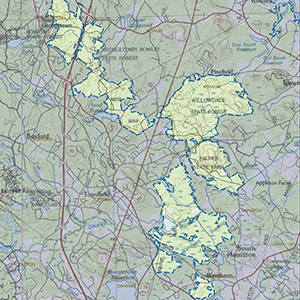Important Bird Area Sites in Massachusetts
Important Bird Area: Eastern Essex County Interior Forest
Site Summary
Nominated By
Jim Berry
Size
7229 acres
Towns and Counties
Ipswich, Hamilton, Wenham, Topsfield, Rowley, Georgetown, Boxford; Essex
Ownership
Department of Environmental Management 63%, Mass Audubon Society 37%
Major Habitats
oak/conifer transitional forest 75%, emergent fresh-water wetland 10%, palustrine wooded swamp 10%, (early successional shrubland, cultural grassland, shrub/scrub wetland, river/stream, migratory stopover site)
Land Use
nature & wildlife, conservation/ land trust, hunting & fishing, other recreation, forestry, water supply, undeveloped
Serious Threats
invasive or non-native plants, cowbird parasitism, residental/ commercial development, disturbance to birds or habitat
Minor Threats
introduced animals/feral pets, recreational development/overuse
IBA Criteria
- Category 1: Sites containing assemblages of species characteristic of a representative, rare, threatened, or unique habitat within the state or region.
- Category 2: Land Birds: The site is an important migratory stopover or seasonal concentration site for migratory land birds (e.g., warblers). Sites may also qualify on the basis of supporting exceptionally high densities of breeding species as shown from point counts or other surveys or if they represent "migrant traps" relative to surrounding areas. Strong consideration will be given to areas with consistently high overall species diversity..
- Category 4: Sites regularly holding significant numbers of species of high conservation priority in Massachusetts.
Site Description
This Important Bird Area is a huge interior mixed-forest ecosystem, covering parts of seven Essex County towns. The area consists of Willowdale State Forest (WSF), 2,400 acres; Cleaveland Farm State Forest (CFSF), 184 acres; Georgetown-Rowley State Forest (GRSF), 1,124 acres; Bradley Palmer State Park (BPSP), 721 acres; and the Mass Audubon Ipswich River Wildlife Sanctuary (IRWS), 2,800 acres. The site is the largest contiguous forest remaining in Northeastern MA, and large parts are unfragmented. It is mostly eastern deciduous and mixed forest habitat, with large amounts of red maple swamp, fresh water marsh, and riverine habitat. A mature, diverse floodplain forest along the Ipswich River, an uncommon forest ecosystem, provides habitat for Red-shouldered Hawks, Wood Ducks, Virginia Rails, warblers, thrushes, and many other floodplain species. The Great Wenham Swamp, largely contained within IRWS, is the largest fresh water marsh on the north shore. The Ipswich River flows through IRWS and between BPSP and WSF.
Current Conservation Status
At IRWS, the invasive plant black swallowwort, is a threat to the forests and fields. Tall manna grass, a Eurasian species not known to exist in the eastern U.S., was discovered in the sanctuary in 1990. It is a highly competitive plant with the ability to dominate wetlands. An eradication program was begun in 1993. The plant has yet to be eradicated, but sanctuary staff is implementing both control and monitoring procedures.
Cowbirds are a serious threat, and can be found deep within any part of this IBA. Development is and will continue to be a serious issue around the perimeters of the forests, but the biggest threat, that of a subdivision in a 40-acre inholding within WSF, was ended by the purchase of the property by a coalition of interests and the addition of the parcel to the state forest. BPSP and IRWS are the most heavily used of the five parcels for recreation, but with most activity confined to the trails and the Ipswich River. However, while off-road vehicles are permitted only in portions of GRSF, the cumulative effect of constant recreation, and in particular the proclivity of dirt bikers to ride wherever they can get away with it, cannot be considered anything less than a serious long-term threat in terms of disturbance to wildlife.
Ornithological Significance
This site is important primarily for concentrations of nesting songbirds, using both upland and wetland habitats. The character as a relatively unfragmented forest supports breeding populations (>25 nesting pairs per species) of ten regional, and five state high conservation priority species. At least three other high conservation priority species breed within this area at lower densities. High concentrations of many other song and marsh birds also breed at this site. In addition, three state listed species breed in or near the large beaver marsh in WSF.
Other Flora or Fauna of Significance
IRWS has three watch-list flora species - river birch, river bulrush, and red pine. Listed herps include the Blue-spotted Salamander. Other rare species include an endangered dragonfly, the Ringed Boghaunter, and a watchlist dragonfly, the Arrowhead Spiketail. Sixty-seven species of butterflies have been recorded. Self-introduced beavers, coyotes, and fishers are well established throughout the IBA. WSF also has (at minimum) Four-toed Salamanders, Blue-spotted Salamanders, Spotted Turtles, Coppery Emeralds, and Mystic Valley Amphipods.
Data Sources
J. Berry, personal observations (estimates based on 20+ yrs. incl. MA breeding bird atlas) and species lists




